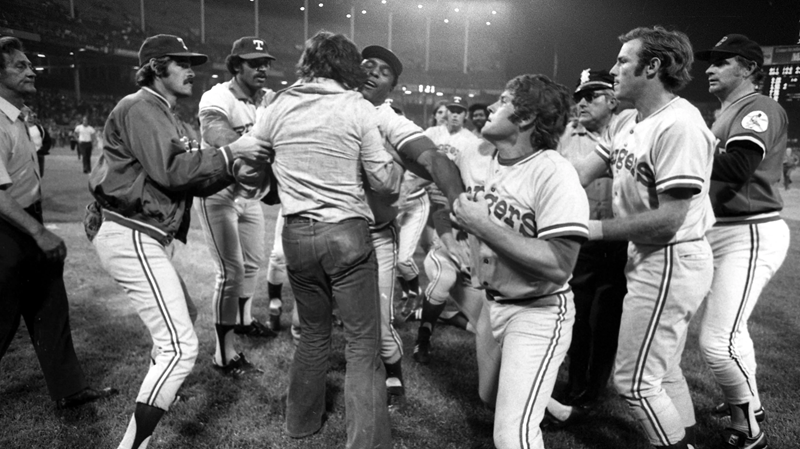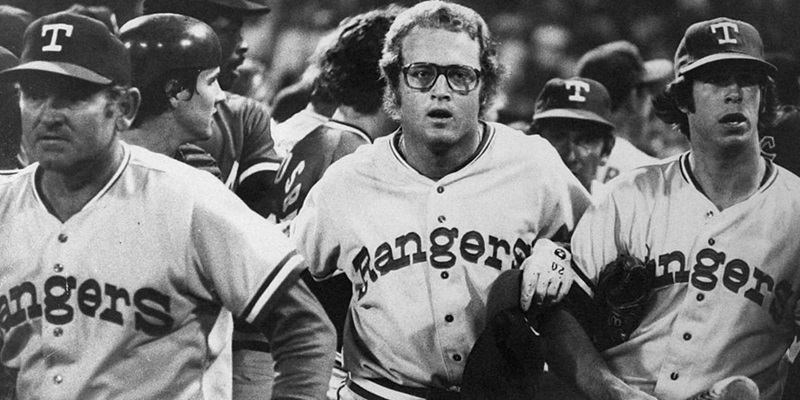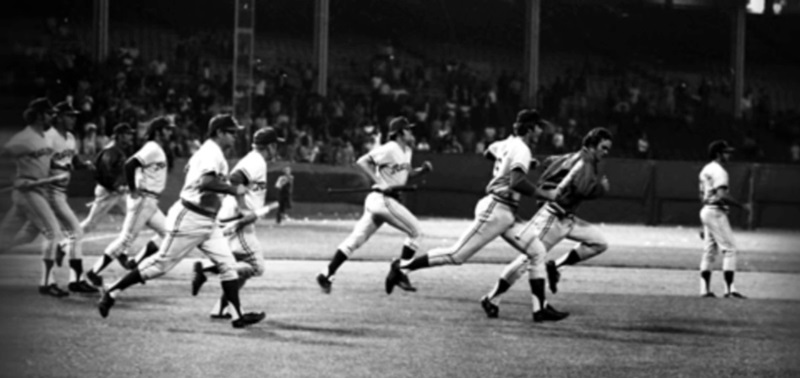50 Years Ago: Cleveland’s Infamous 10-Cent Beer Night
Half a century ago, on June 4, 1974, a promotional attempt by the Cleveland Indians’ management turned into an unforgettable night that has since been etched into the annals of sports history. The event was dubbed as the 10-cent Beer Night, and it’s infamous for the chaos that ensued.
This night was meant to draw a large crowd to the Indians’ game against the Texas Rangers by offering beer at a meager price of ten cents per cup, a significant drop from the regular price of sixty-five cents. The management hoped that the promotion would fill the stadium, boost morale, and perhaps even help the team snap their losing streak.
However, instead of the desired outcome, the event became a lesson for future sports promotions. The combination of low-cost alcohol and a crowd of over 25,000 spectators resulted in a scenario that quickly spiraled out of control. The attendees, many of whom had already consumed alcohol before the game, exploited the inexpensive beer offer, leading to widespread drunkenness.
The atmosphere in the stadium grew increasingly volatile and disruptive as the game progressed, with many fans hurling objects onto the field, invading the pitch, and even engaging in physical altercations with the players.
The situation reached a tipping point in the ninth inning when a fan attempted to steal a player’s cap, leading to a full-scale riot. The game had to be forfeited, and it took a combined effort of the teams and stadium security to restore order. The 10-cent Beer Night was a stark example of a well-intentioned promotional event that took an unexpected turn due to an underestimation of crowd behavior and the effects of alcohol.
In the aftermath, the incident served as a case study for sports events management, and new measures were put into place to ensure the safety and regulation of such promotions. Despite the negative press and the significant damage, the incident did not deter the Cleveland Indians from repeating the promotion later that year, albeit with stricter regulations. The event remains a controversial moment in the history of Major League Baseball.
For Cleveland, the 10-cent Beer Night was more than just a baseball game. It was a moment that showcased the city’s passionate sports culture, even though it was marred by chaos and disorder. Today, the event is remembered as a cautionary tale about the unforeseen consequences of sports promotions and the unpredictable nature of crowd behavior. Despite the unfortunate events that transpired that night, the 10-cent Beer Night will forever be a part of Cleveland’s rich sports history, a testament to the city’s resilience and love for baseball.

Event Overview: What Happened on 10-Cent Beer Night
On June 4, 1974, an infamous incident in the history of American sports occurred. This was 10-cent beer night at Cleveland Stadium during a Major League Baseball game between the Cleveland Indians and the Texas Rangers. The promotional event, which offered unlimited beer at a mere ten cents per cup, was intended to attract larger crowds. Unfortunately, it led to an unexpected level of chaos and disorder. As the game progressed, the inebriated crowd became progressively more unruly.
Many spectators began throwing objects onto the field, and a few even ventured onto it, disrupting the game. The situation escalated when the Indians tied the game in the ninth inning, and the crowd’s disruptive behavior intensified. Things took a turn for the worse when a fan attempted to steal a cap from a Texas Ranger player, inciting a brawl between the players and the fans. The riotous scene that ensued forced the umpires to forfeit the game in favor of Texas, stating that Cleveland was unable to provide a safe playing environment.
The 10-cent beer night incident has since been embedded in the annals of American sports history as a cautionary tale. The promotion, while financially attractive, did not consider the potential consequences of mixing alcohol and competitive sports. The event underscores the importance of responsible alcohol consumption and proper crowd control measures during sporting events. Despite the incident’s notoriety, the MLB has continued to allow alcohol sales at games but has since implemented stricter regulations and limits to prevent similar incidents from occurring.
Baseball, beers and bedlam
Baseball, beers, and bedlam, a trifecta of American pastime that brings forth a unique blend of joy, excitement, and chaos. Picture this: the crack of a bat connecting with a ball, the cheers of the crowd echoing through the stadium, the smell of hot dogs wafting through the air, and the taste of a cold beer on a sunny afternoon. This is the essence of a baseball game, a tradition deeply embedded in the heart of American culture. But, with the exhilarating atmosphere and the free-flowing beer, often comes a touch of bedlam. The unruly energy of a lively crowd can sometimes tip over to the side of pandemonium.
Overzealous fans may occasionally cause a ruckus, their fervor fueled by their love for the game and, quite possibly, one too many beers. These instances of disorder, while not the norm, are part of the game’s folklore, adding a dash of unpredictability to an otherwise structured sport. They serve as reminders that while baseball, like most sports, is a game of discipline and strategy, it is also a social event where passion, rivalry, and camaraderie are at play. The combination of baseball, beers, and occasional bedlam paints a vibrant picture of a cultural phenomenon that is much more than just a sport.
It’s a spectacle, a community, and a testament to the spirit of competition, camaraderie, and revelry that lies at the heart of American society. Whether it’s the thrill of the game, the camaraderie in the stands, or the unpredictability of the crowd, baseball, beers, and bedlam continue to offer a unique, intoxicating experience that keeps fans coming back for more.

Fan Behavior and Stadium Atmosphere
Fan behavior significantly impacts the atmosphere within a stadium. Enthusiastic and passionate supporters can create an electric, vibrant atmosphere that drives their team forward. Their chanting, cheering, and singing can serve as the heart and soul of a match, making the stadium come alive. It fosters a sense of camaraderie among supporters, and when positive, fan behavior can enhance the overall experience, making it memorable for everyone present.
However, it’s crucial to remember that fan behavior can also negatively affect the stadium atmosphere. For instance, instances of excessive rowdiness, misuse of flares, or disrespectful chants can create an uncomfortable and intimidating environment. This not only detracts from the enjoyment of the game, but it can also potentially endanger other spectators and players. Moreover, discriminatory behavior such as racism or homophobia has no place in the stadium and tarnishes the spirit of sportsmanship.
Fans should remember that their conduct reflects on their team and fellow supporters. Therefore, it’s essential to maintain respect for everyone in the stadium, including the opposition and their fans, as well as the match officials. An optimal stadium atmosphere is one where everyone can enjoy the game in a safe, exciting, and respectful environment.
Equally important is the role of the clubs and stadium management in promoting positive fan behavior. They can do this by encouraging respect for diversity, implementing measures to curb unruly actions, and promoting a family-friendly atmosphere.
In the end, the stadium atmosphere is like a mirror reflecting the behavior of its fans. It can either shine with excitement, unity, and respect or be clouded by unruliness and disrespect. It’s up to every individual in the stadium to contribute to a positive atmosphere that celebrates the game and respects everyone’s right to enjoy it.
The dust settles
After the chaotic whirlwind of events, the dust finally begins to settle. The relentless frenzy of activity that once filled the air slowly starts to calm, leaving behind a sense of tranquility. Every particle that was once airborne begins to descend, landing softly upon the cold, hard ground. The aftermath is a poignant landscape; the severity of impact is evident in every corner, every nook, and every cranny. It is a scene that tells tales of struggle, of fight, of perseverance. It is an echo of the turmoil that had once consumed the space, now silenced by the gentle hush of settled dust.
This settling is not just a physical phenomenon. It is a metaphor for the calm after a storm, a signal of respite after a period of immense turmoil. It signifies the end of a chapter, the closure of an event, the conclusion of a story. It is a moment of reflection, of contemplation, of introspection. It is a chance to look back on past events, to learn from them, and to prepare for the future.
Yet, it is also a moment of uncertainty. For once the dust settles, it leaves behind a new reality. It uncovers the aftermath, the consequences, the results. It reveals the truth, the reality, the facts. It is a revelation, a discovery, a revelation. It forces a confrontation with the outcomes, the implications, the ramifications. It is a moment of reckoning, of accountability, of responsibility.
However, as unsettling as it may be, this moment also brings hope. For once the dust settles, it leaves behind a clean slate, a fresh start, a new beginning. It offers a chance to rebuild, to recover, to rejuvenate. It provides an opportunity to correct, to amend, to improve. It is a promise of better times, of brighter days, of hopeful tomorrows. Indeed, as the saying goes, where there’s life, there’s hope. And where there’s hope, there’s a chance for the dust to settle and for life to flourish once again.
Impact on Cleveland Indians and Opponents
The Cleveland Indians’ decision to change their name after more than a century is a significant move that reverberates across the sports world, especially impacting those who have been opponents on the field. The decision echoes the sentiments of a society that has become more sensitive to cultural and racial stereotypes. For years, the team and its fans defended their use of a moniker and logo that many others saw as offensive.
However, the shift is more than just a cosmetic change; it represents a cultural shift in understanding and respecting the diversity of the American population. For opponents, this signifies a change in the dynamics of the field where traditions are being challenged in the face of evolving social norms. The change may also affect the competitive spirit, as teams who were traditionally rivals may feel the emotional impact of this shift.
Although some may argue that this change is merely superficial and does not affect the actual gameplay, it cannot be denied that the team’s identity forms an integral part of their overall morale and motivation. Therefore, changing team names and mascots can have a profound psychological impact on players, fans, and even opponents. It is an acknowledgment of a long-overdue respect for indigenous cultures and may lead other teams to reconsider similar changes.
Despite the controversy, it is evident that this move resonates deeply within the sports arena and beyond, paving the way for a more inclusive future. The Cleveland Indians’ name change is not just a new chapter in the team’s history, but also a significant milestone in the evolution of American society’s perception of cultural sensitivity and respect for diversity.
Media and Public Reaction
Media has an incredible influence on public reaction, shaping opinions and guiding discussions on various issues. It often serves as a conduit for information dissemination, thus having a profound impact on the public’s perception and understanding of different matters. This influence can be seen in various facets of society, including politics, economics, and social issues.
The media’s role in shaping public opinion cannot be overstated. For instance, the manner in which a news story is presented can dramatically affect the audience’s response. If the media portrays a situation in a positive light, the public is likely to respond favorably. Conversely, if the media presents an issue negatively, it can incite a negative public reaction.
However, the media’s influence on public reaction is not always straightforward. The advent of social media has significantly altered the relationship between the media and the public. Now, the public has the ability to generate and share their own content, contributing to the media landscape and influencing public reaction in ways that were not possible before.
Moreover, the public’s trust in the media is a crucial factor in how much influence the media can exert. If the public perceives the media as biased or unreliable, they may be less likely to be swayed by its narratives. On the other hand, a trusted media outlet can greatly influence public reaction, even on contentious issues.
In conclusion, the media plays a critical role in shaping public reaction. Its influence is complex and multifaceted, affected by various factors such as its presentation of issues, the advent of social media, and the level of trust the public has in it. As such, it is crucial for media outlets to uphold ethical standards in their reporting to maintain public trust and ensure accurate public reactions.

Conclusion: Remembering Cleveland’s 10-Cent Beer Night
In conclusion, Cleveland’s infamous 10-Cent Beer Night remains a poignant memory in the city’s baseball history, a cautionary tale about the unpredictable consequences of alcohol-fueled revelry. It was a night when beer was sold for a mere dime, leading to an eruption of chaos as fans, fueled by excessive alcohol consumption, stormed the field and disrupted the game. The event, which took place on June 4, 1974, during a match between the Cleveland Indians and Texas Rangers, ended in a forfeit for the home team due to the uncontrollable behavior of the crowd.
This controversial promotional event has since become a benchmark for extreme sports promotions and a lesson in crowd management. It serves as a stark reminder of the significant impact of alcohol on crowd behavior, particularly in sporting events.
The incident also underscored the necessity for sports venues to maintain a balance between enticing fan participation through promotions and ensuring the safety and decorum of the event. While it may have been intended as an innocent marketing stunt to increase attendance, the consequences of Cleveland’s 10-Cent Beer Night serve as a lasting lesson in the annals of sports history.
Despite the chaos, it has become a folklore of sorts for Cleveland, often talked about with a mix of disbelief and amusement. It highlighted the unpredictable nature of crowd dynamics and the importance of responsible drinking. Although it’s doubtful such an event would be repeated in today’s more security-conscious sports culture, the memory of that chaotic night continues to resonate as an example of how things can quickly spiral out of control.